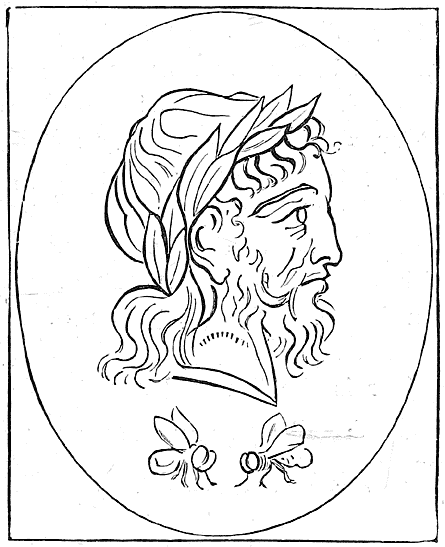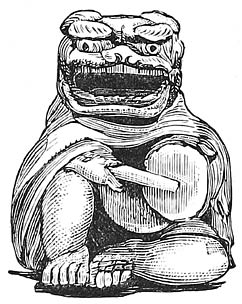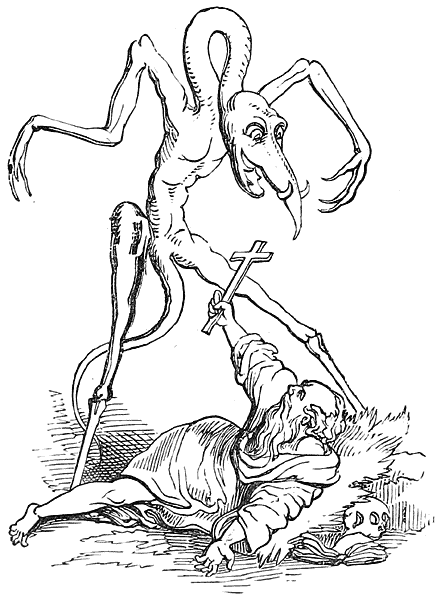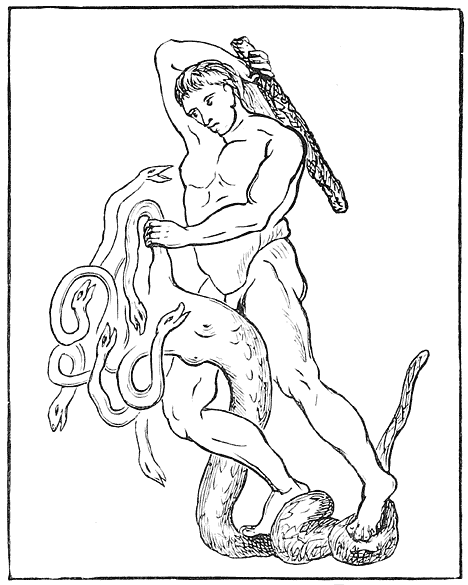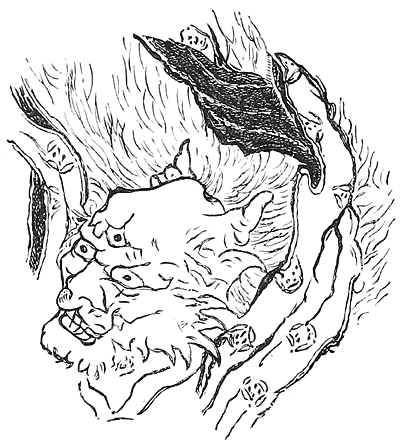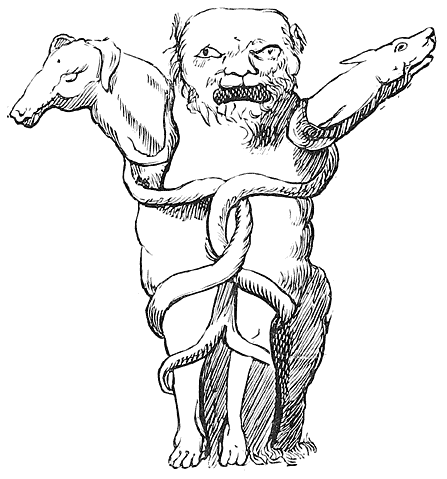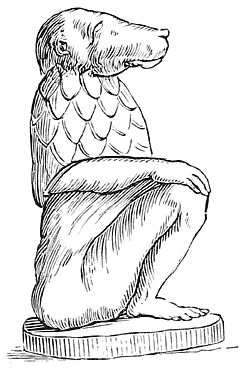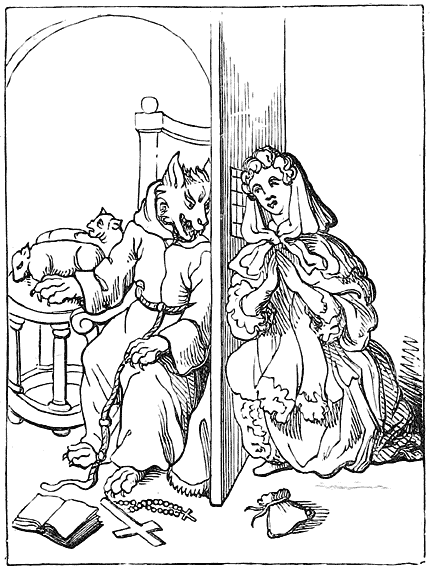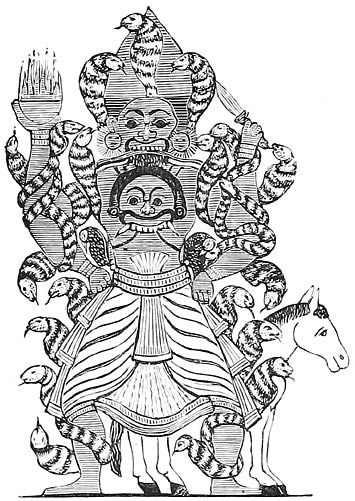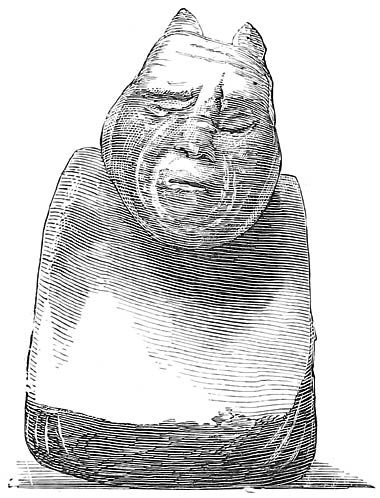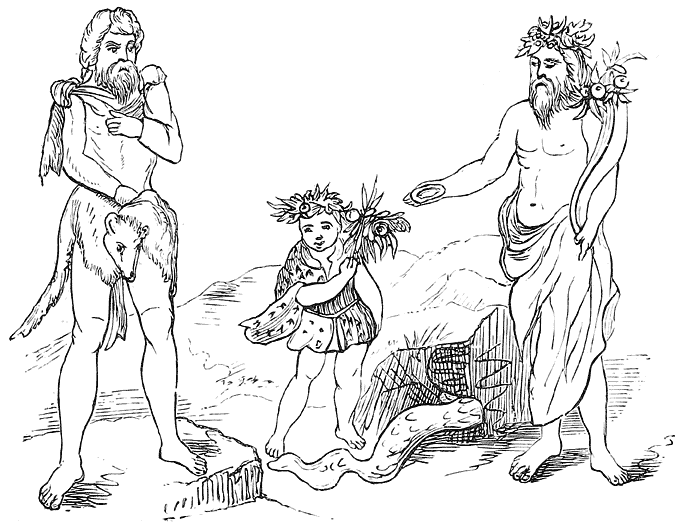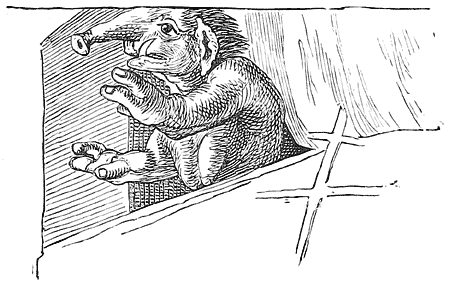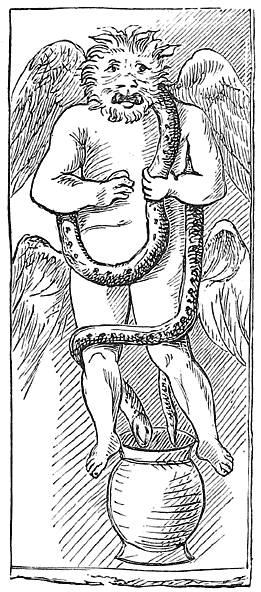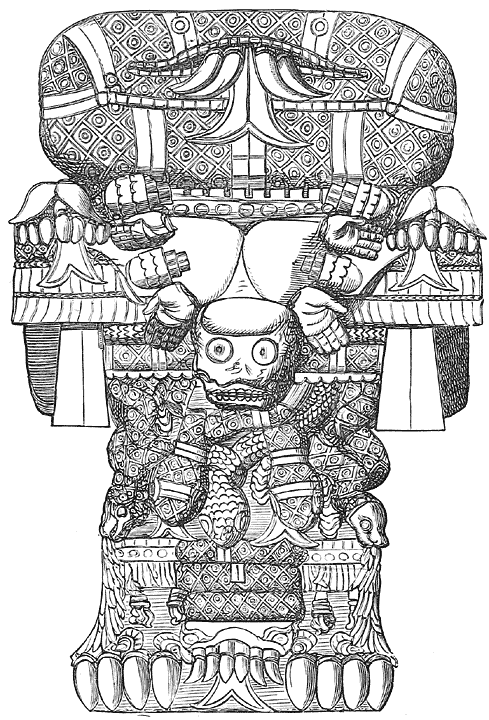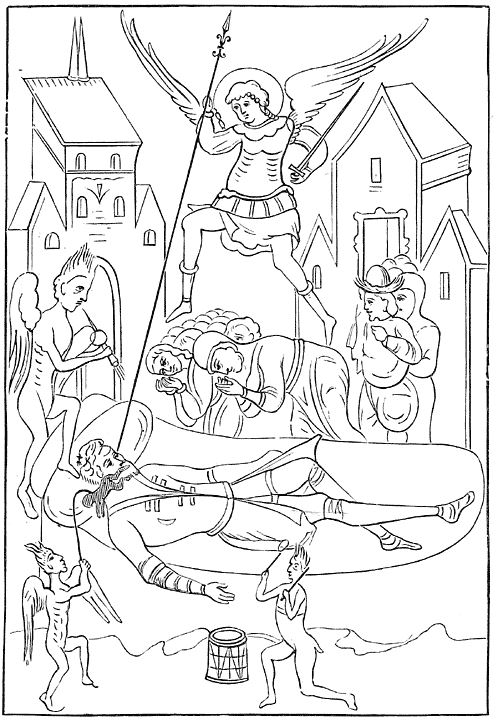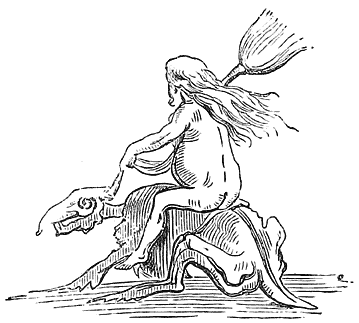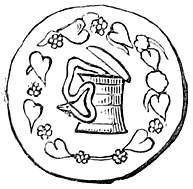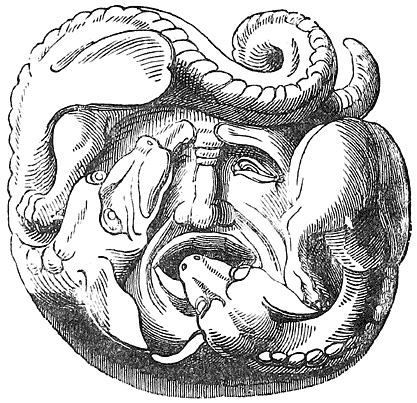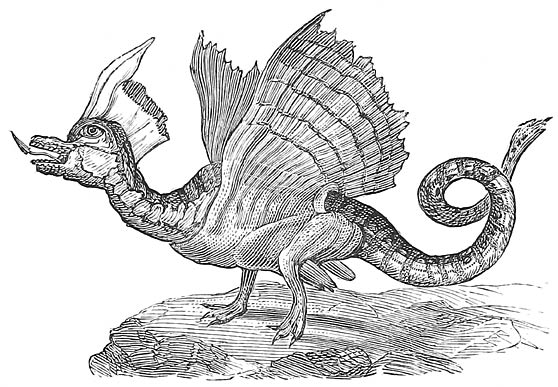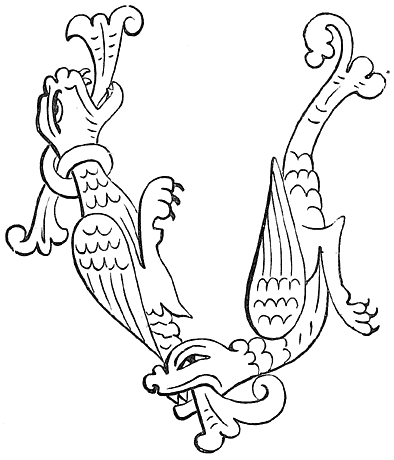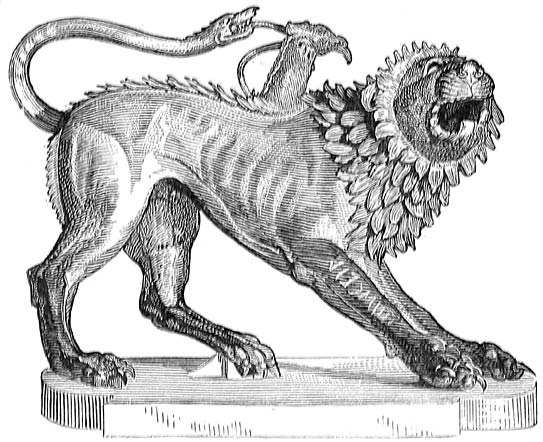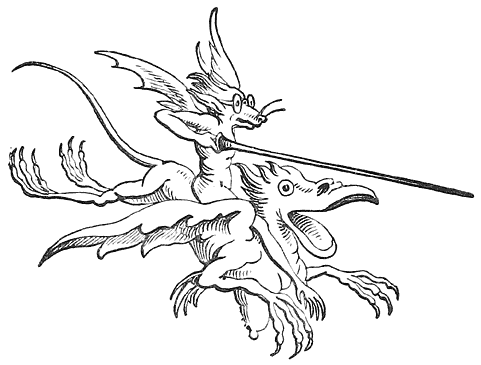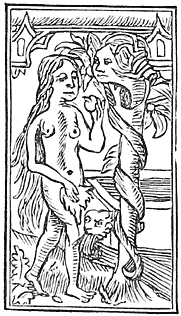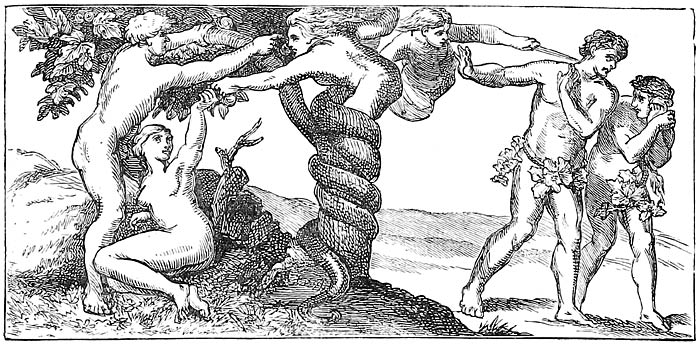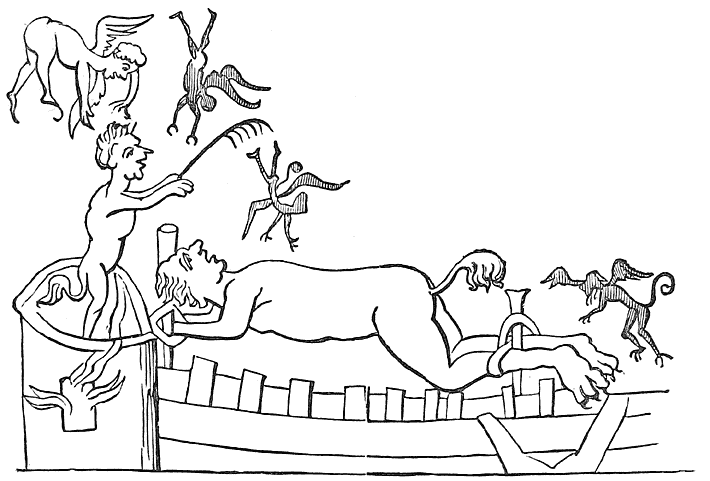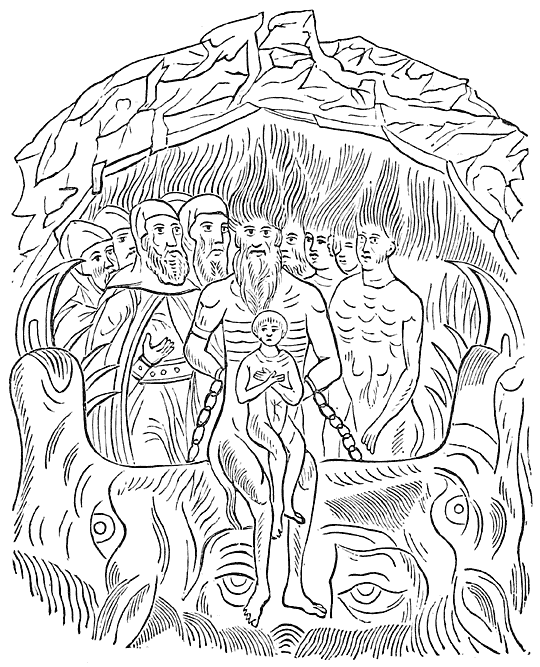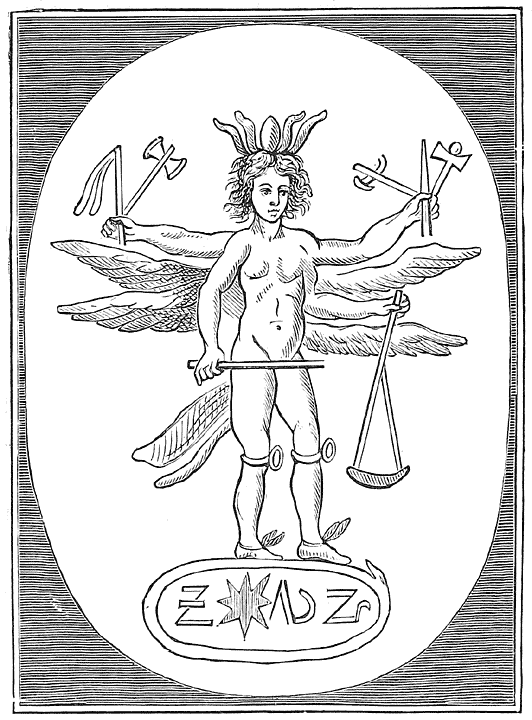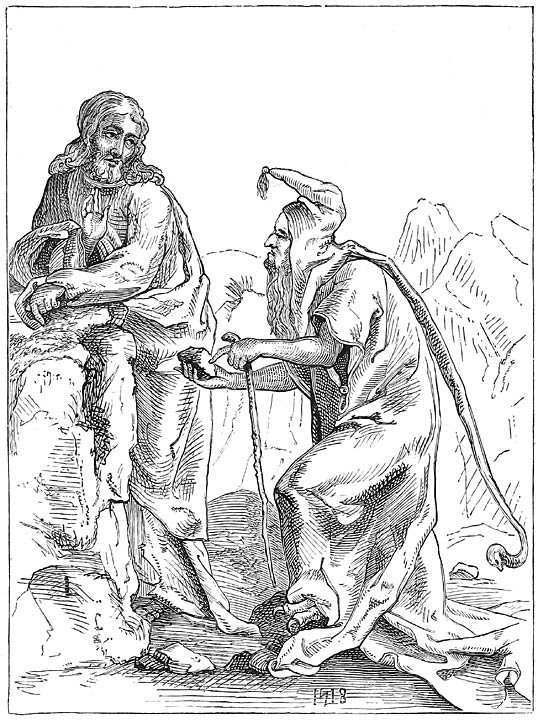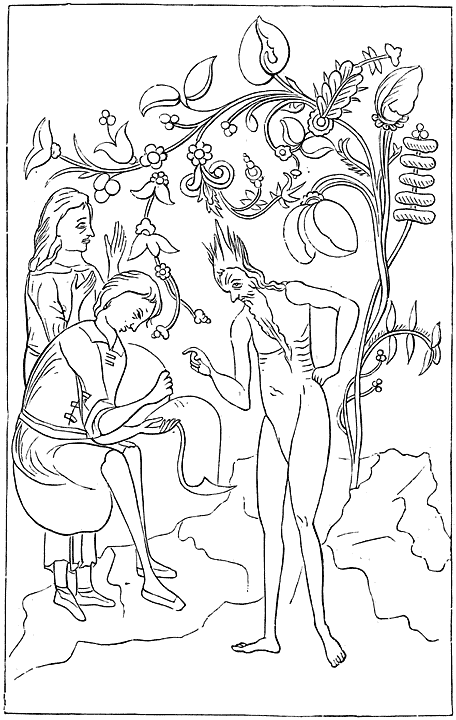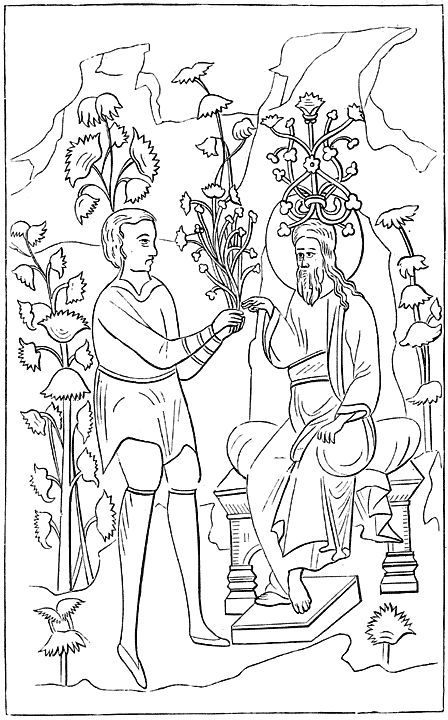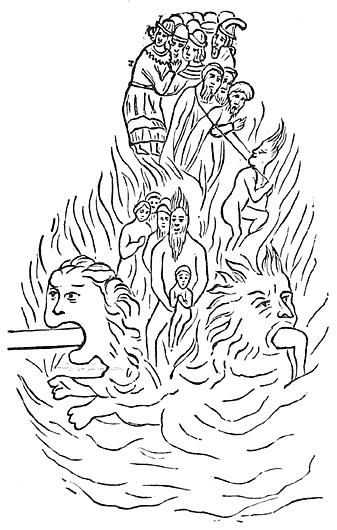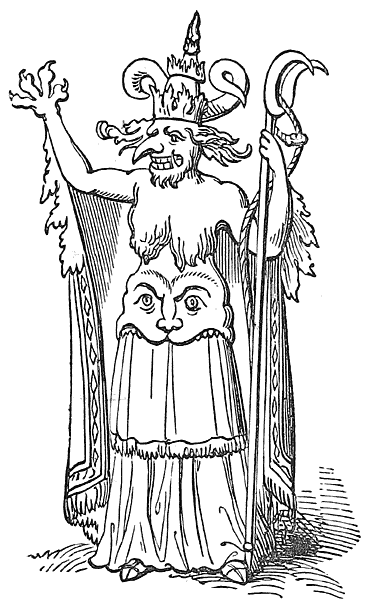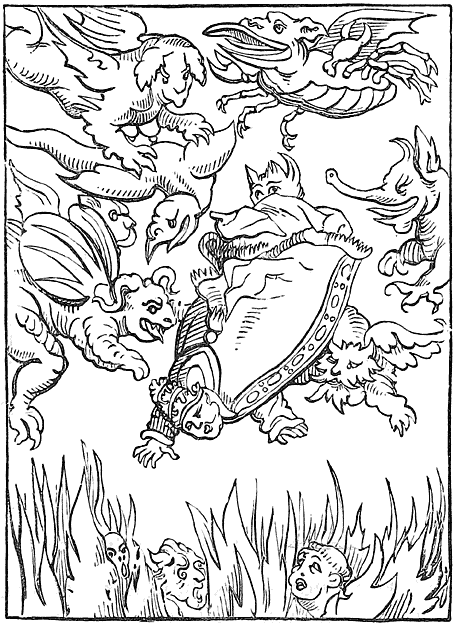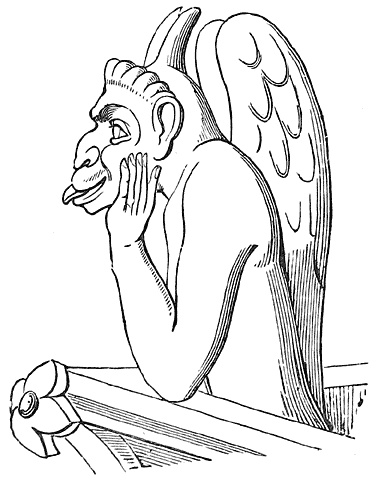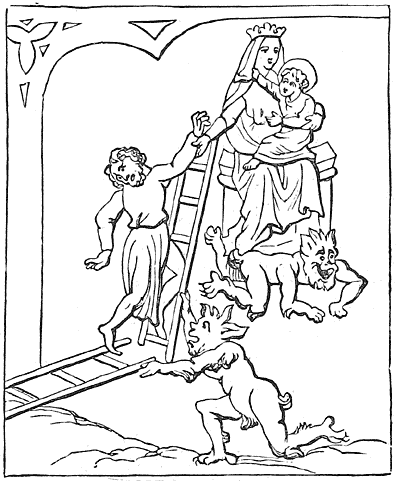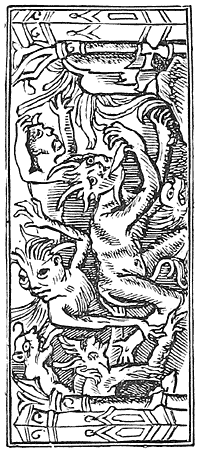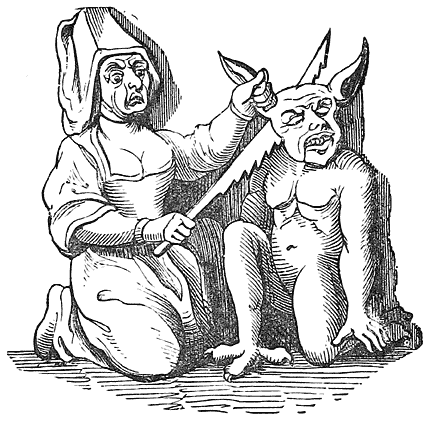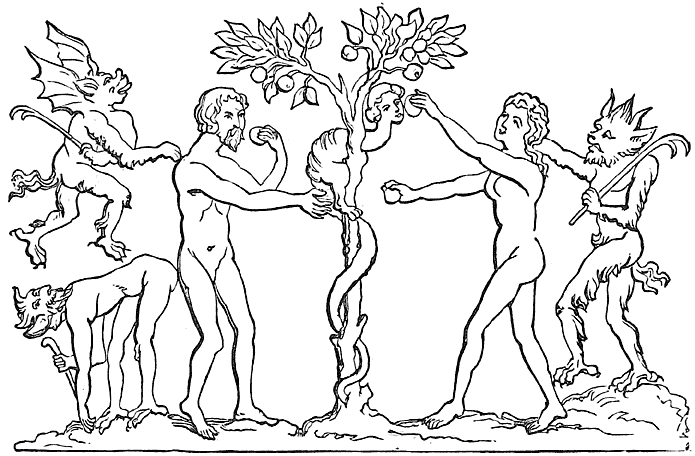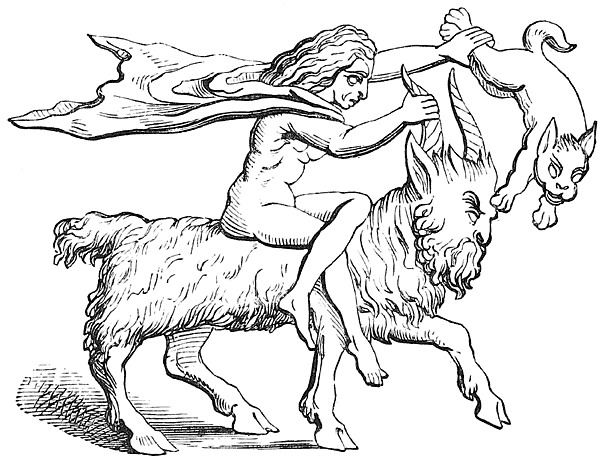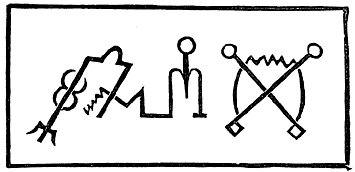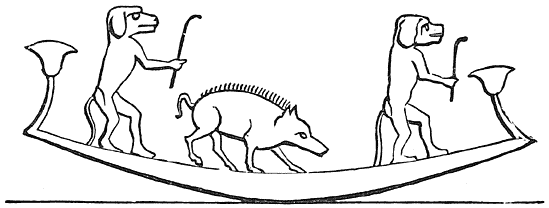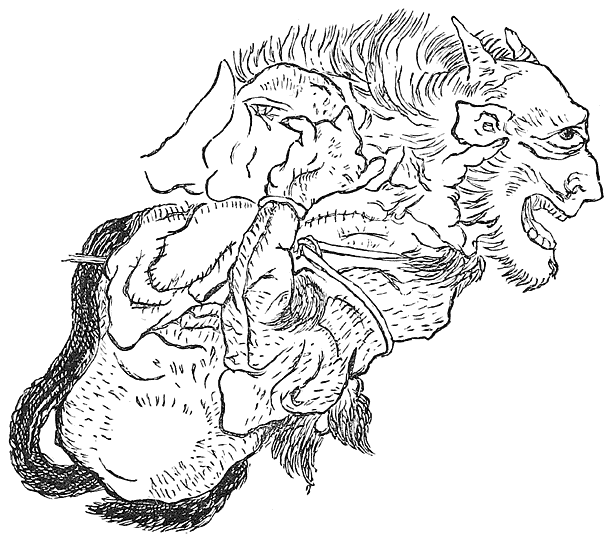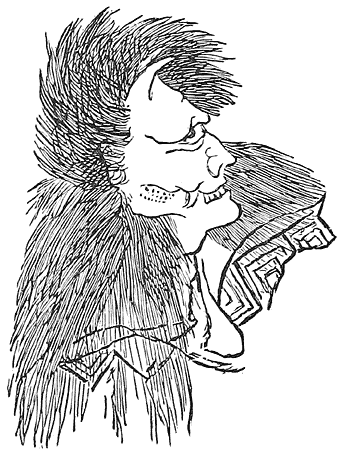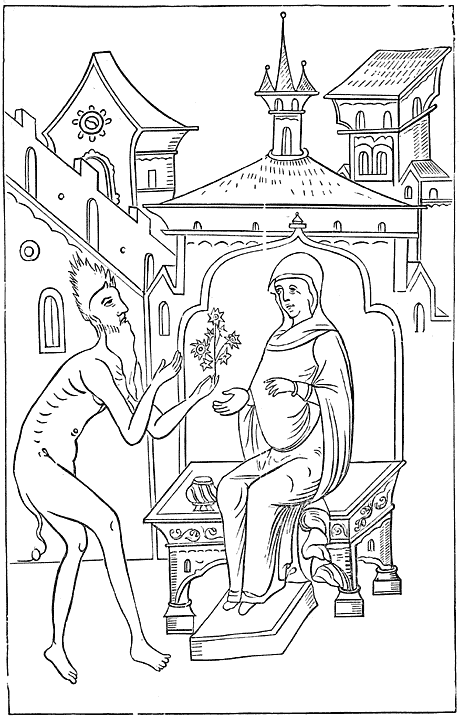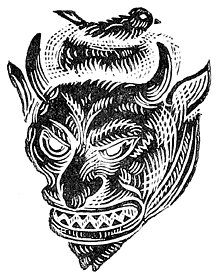


New York
Henry Holt and Company
1879
Preface.
Three Friars, says a legend, hid themselves near the Witch Sabbath orgies that they might count the devils; but the Chief of these, discovering the friars, said—‘Reverend Brothers, our army is such that if all the Alps, their rocks and glaciers, were equally divided among us, none would have a pound’s weight.’ This was in one Alpine valley. Any one who has caught but a glimpse of the world’s Walpurgis Night, as revealed in Mythology and Folklore, must agree that this courteous devil did not overstate the case. Any attempt to catalogue the evil spectres which have haunted mankind were like trying to count the shadows cast upon the earth by the rising sun. This conviction has grown upon the author of this work at every step in his studies of the subject.
In 1859 I contributed, as one of the American ‘Tracts for the Times,’ a pamphlet entitled ‘The Natural History of the Devil.’ Probably the chief value of that essay was to myself, and this in that its preparation had revealed to me how pregnant with interest and importance was the subject selected. Subsequent researches in the same direction, after I had come to reside in Europe, revealed how slight had been my conception of the vastness of the domain upon which that early venture was made. In 1872, while preparing a series of lectures for the Royal [vi]Institution on Demonology, it appeared to me that the best I could do was to print those lectures with some notes and additions; but after they were delivered there still remained with me unused the greater part of materials collected in many countries, and the phantasmal creatures which I had evoked would not permit me to rest from my labours until I had dealt with them more thoroughly.
The fable of Thor’s attempt to drink up a small spring, and his failure because it was fed by the ocean, seems aimed at such efforts as mine. But there is another aspect of the case which has yielded me more encouragement. These phantom hosts, however unmanageable as to number, when closely examined, present comparatively few types; they coalesce by hundreds; from being at first overwhelmed by their multiplicity, the classifier finds himself at length beating bushes to start a new variety. Around some single form—the physiognomy, it may be, of Hunger or Disease, of Lust or Cruelty—ignorant imagination has broken up nature into innumerable bits which, like mirrors of various surface, reflect the same in endless sizes and distortions; but they vanish if that central fact be withdrawn.
In trying to conquer, as it were, these imaginary monsters, they have sometimes swarmed and gibbered around me in a mad comedy which travestied their tragic sway over those who believed in their reality. Gargoyles extended their grin over the finest architecture, cornices coiled to serpents, the very words of speakers started out of their conventional sense into images that tripped my attention. Only as what I believed right solutions were given to their problems were my sphinxes laid; but through this psychological experience it [vii]appeared that when one was so laid his or her legion disappeared also. Long ago such phantasms ceased to haunt my nerves, because I discovered their unreality; I am now venturing to believe that their mythologic forms cease to haunt my studies, because I have found out their reality.
Why slay the slain? Such may be the question that will arise in the minds of many who see this book. A Scotch song says, ‘The Devil is dead, and buried at Kirkcaldy;’ if so, he did not die until he had created a world in his image. The natural world is overlaid by an unnatural religion, breeding bitterness around simplest thoughts, obstructions to science, estrangements not more reasonable than if they resulted from varying notions of lunar figures,—all derived from the Devil-bequeathed dogma that certain beliefs and disbeliefs are of infernal instigation. Dogmas moulded in a fossil demonology make the foundation of institutions which divert wealth, learning, enterprise, to fictitious ends. It has not, therefore, been mere intellectual curiosity which has kept me working at this subject these many years, but an increasing conviction that the sequelæ of such superstitions are exercising a still formidable influence. When Father Delaporte lately published his book on the Devil, his Bishop wrote—‘Reverend Father, if every one busied himself with the Devil as you do, the kingdom of God would gain by it.’ Identifying the kingdom here spoken of as that of Truth, it has been with a certain concurrence in the Bishop’s sentiment that I have busied myself with the work now given to the public. [ix]
Contents
Volume I.
Part I.
Chapter I.
Page
Origin of Deism—Evolution from the far to the near—Illustrations from Witchcraft—The primitive Pantheism—The dawn of Dualism 1
Chapter II.
Their good names euphemistic—Their mixed character—Illustrations: Beelzebub, Loki—Demon-germs—The knowledge of good and evil—Distinction between Demon and Devil 7
Chapter III.
The degradation of Deities—Indicated in names—Legends of their fall—Incidental signs of the divine origin of Demons and Devils 15
Chapter IV.
The ex-god—Deities demonised by conquest—Theological animosity—Illustration from the Avesta—Devil-worship an arrested Deism—Sheik Adi—Why Demons were painted ugly—Survivals of their beauty 22 [x]
Chapter V.
The obstructions of man—The twelve chief classes—Modifications of particular forms for various functions—Theological Demons 34
Part II.
Chapter I.
Hunger-demons—Kephn—Miru—Kagura—Ráhu the Hindu sun-devourer—The earth monster at Pelsall—A Franconian custom—Sheitan as moon-devourer—Hindu offerings to the dead—Ghoul—Goblin—Vampyres—Leanness of demons—Old Scotch custom—The origin of sacrifices 41
Chapter II.
Demons of fire—Agni—Asmodeus—Prometheus—Feast of fire—Moloch—Tophet—Genii of the lamp—Bel-fires—Hallowe’en—Negro superstitions—Chinese fire-god—Volcanic and incendiary demons—Mangaian fire-demon—Demons’ fear of water 57
Chapter III.
Descent of Ishtar into Hades—Bardism—Baldur—Herakles—Christ—Survivals of the Frost Giant in Slavonic and other countries—The Clavie—The Frozen Hell—The Northern abode of Demons—North side of churches 77
Chapter IV.
A Scottish Munasa—Rudra—Siva’s lightning eye—The flaming sword—Limping Demons—Demons of the storm—Helios, Elias, Perun—[xi]Thor arrows—The Bob-tailed Dragon—Whirlwind—Japanese Thunder God—Christian survivals—Jinni—Inundations—Noah—Nik, Nicholas, Old Nick—Nixies—Hydras—Demons of the Danube—Tides—Survivals in Russia and England 92
Chapter V.
Animal demons distinguished—Trivial sources of Mythology—Hedgehog—Fox—Transmigrations in Japan—Horses bewitched—Rats—Lions—Cats—The Dog—Goethe’s horror of dogs—Superstitions of the Parsees, people of Travancore, and American Negroes, Red Indians, &c.—Cynocephaloi—The Wolf—Traditions of the Nez Perces—Fenris—Fables—The Boar—The Bear—Serpent—Every animal power to harm demonised—Horns 121
Chapter VI.
Aryas, Dasyus, Nagas—Yakkhos—Lycians—Ethiopians—Hirpini—Polites—Sosipolis—Were-wolves—Goths and Scythians—Giants and Dwarfs—Berserkers—Britons—Iceland—Mimacs—Gog and Magog 150
Chapter VII.
Indian Famine and Sun-spots—Sun-worship—Demon of the Desert—The Sphinx—Egyptian Plagues described by Lepsius: Locusts, Hurricane, Flood, Mice, Flies—The Sheikh’s ride—Abaddon—Set—Typhon—The Cain wind—Seth—Mirage—The Desert Eden—Azazel—Tawiscara and the Wild-rose 170
Chapter VIII.
Mephistopheles on crags—Emerson on Monadnoc—Ruskin on Alpine peasants—Holy and unholy mountains—The Devil’s Pulpit—Montagnards—Tarns—Tenjo—T’ai-shan—Apocatequil—Tyrolese legends—Rock ordeal—Scylla and Charybdis—Scottish giants—Pontifex—Devil’s bridges—Le géant Yéous 190 [xii]
Chapter IX.
Maya—Natural Treacheries—Misleaders—Glamour—Lorelei—Chinese Mermaid—Transformations—Swan Maidens—Pigeon Maidens—The Seal-skin—Nudity—Teufelsee—Gohlitsee—Japanese Siren—Dropping Cave—Venusberg—Godiva—Will-o’-Wisp—Holy Fräulein—The Forsaken Merman—The Water-Man—Sea Phantom—Sunken Treasures—Suicide 210
Chapter X.
Shadows—Night Deities—Kobolds—Walpurgisnacht—Night as Abettor of Evil-doers—Nightmare—Dreams—Invisible Foes—Jacob and his Phantom—Nott—The Prince of Darkness—The Brood of Midnight—Second-Sight—Spectres of Souter Fell—The Moonshine Vampyre—Glamour—Glam and Grettir—A-Story of Dartmoor 231
Chapter XI.
The Plague Phantom—Devil-dances—Destroying Angels—Ahriman in Astrology—Saturn—Satan and Job—Set—The Fatal Seven—Yakseyo—The Singhalese Pretraya—Reeri—Maha Sohon—Morotoo—Luther on Disease-demons—Gopolu—Madan—Cattle-demon in Russia—Bihlweisen—The Plough 249
Chapter XII.
The Vendetta of Death—Teoyaomiqui—Demon of Serpents—Death on the Pale Horse—Kali—War-gods—Satan as Death—Death-beds—Thanatos—Yama—Yimi—Towers of Silence—Alcestis—Herakles, Christ, and Death—Hell—Salt—Azraël—Death and the Cobbler—Dance of Death—Death as Foe and as Friend 269 [xiii]
Part III.
Chapter I.
The Holy Tree of Travancore—The growth of Demons in India, and their decline—The Nepaul Iconoclast—Moral Man and unmoral Nature—Man’s physical and mental migrations—Heine’s ‘Gods in Exile’—The Goban Saor—Master Smith—A Greek caricature of the Gods—The Carpenter v. Deity and Devil—Extermination of the Were-wolf—Refuges of Demons—The Giants reduced to Little People—Deities and Demons returning to nature 299
Chapter II.
The Demons’ bequest to their conquerors—Nondescripts—Exaggerations of Tradition—Saurian Theory of Dragons—The Dragon not primitive in Mythology—Monsters of Egyptian, Iranian, Vedic, and Jewish Mythologies—Turner’s Dragon—Della Bella—The Conventional Dragon 318
Chapter III.
The beauty of the Serpent—Emerson on ideal forms—Michelet’s thoughts on the viper’s head—Unique characters of the Serpent—The Monkey’s horror of Snakes—The Serpent protected by superstition—Human defencelessness against its subtle powers—Dubufe’s picture of the Fall of Man 325
Chapter IV.
An African Serpent-drama in America—The Veiled Serpent—The Ark of the Covenant—Aaron’s Rod—The Worm—An Episode on the Dii Involuti—The Serapes—The Bambino at Rome—Serpent-transformations 332 [xiv]
Chapter V.
The Naturalistic Theory of Apophis—The Serpent of Time—Epic of the Worm—The Asp of Melite—Vanquishers of Time—Nachash-Beriach—The Serpent-Spy—Treading on Serpents 340
Chapter VI.
The Kankato na—The Vedic Serpents not worshipful—Ananta and Sesha—The Healing Serpent—The guardian of treasures—Miss Buckland’s theory—Primitive rationalism—Underworld plutocracy—Rain and lightning—Vritra—History of the word ‘Ahi’—The Adder—Zohak—A Teutonic Laokoon 348
Chapter VII.
The Serpent’s gem—The Basilisk’s eye—Basiliscus mitratus—House-snakes in Russia and Germany—King-snakes—Heraldic Dragon—Henry III.—Melusina—The Laidley Worm—Victorious Dragons—Pendragon—Merlin and Vortigern—Medicinal dragons 361
Chapter VIII.
The Eye of Evil—Turner’s Dragons—Cloud-phantoms—Paradise and the Snake—Prometheus and Jove—Art and Nature—Dragon forms: Anglo-Saxon, Italian, Egyptian, Greek, German—The modern conventional Dragon 372
Chapter IX.
The pre-Munchausenite world—The Colonial Dragon—Io’s journey—Medusa—British Dragons—The Communal Dragon—Savage Saviours—A Mimac helper—The Brutal Dragon—Woman protected—The Saint of the Mikados 384 [xv]
Chapter X.
Demi-gods—Alcestis—Herakles—The Ghilghit Fiend—Incarnate deliverer of Ghilghit—A Dardistan Madonna—The religion of Atheism—Resuscitation of Dragons—St. George and his Dragon—Emerson and Ruskin on George—Saintly allies of the Dragon 394
Chapter XI.
Medusa—Phenomena of recurrence—The Brood of Echidna and their survival—Behemoth and Leviathan—The Mouth of Hell—The Lambton Worm—Ragnar—The Lambton Doom—The Worm’s Orthodoxy—The Serpent, Superstition, and Science 406
Chapter XII.
Doré’s ‘Love and Fate’—Moira and Moiræ—The ‘Fates’ of Æschylus—Divine absolutism surrendered—Jove and Typhon—Commutation of the Demon’s share—Popular fatalism—Theological fatalism—Fate and Necessity—Deification of Will—Metaphysics, past and present 420 [xvi]
Volume II.
Part IV.
Chapter I.
Diabolism. Page
Dragon and Devil distinguished—Dragons’ wings—War in Heaven—Expulsion of Serpents—Dissolution of the Dragon—Theological origin of the Devil—Ideal and Actual—Devil Dogma—Debasement of ideal persons—Transmigration of phantoms 1
Chapter II.
Respect for the Devil—Primitive Atheism—Idealisation—Birth of new gods—New gods diabolised—Compromise between new gods and old—Foreign deities degraded—Their utilisation 13
Chapter III.
Mr. Irving’s impersonation of Superstition—Revolution against pious privilege—Doctrine of ‘Merits’—Saintly immorality in India—A Pantheon turned Inferno—Zendavesta on Good and Evil—Parsî Mythology—The Combat of Ahriman with Ormuzd—Optimism—Parsî Eschatology—Final Restoration of Ahriman 20
Chapter IV.
Viswámitra, the Theocratic Devil.
Priestcraft and Pessimism—An Aryan Tetzel and his Luther—Brahman Frogs—Evolution of the Sacerdotal Saint—Viswámitra the Accuser of Virtue—The Tamil Passion-Play ‘Harischandra’—Ordeal of Goblins—The Martyr of Truth—Virtue triumphant over ceremonial ‘Merits’—Harischandra and Job 31 [vi]
Chapter V.
Deified power—Giants and Jehovah—Jehovah’s manifesto—The various Elohim—Two Jehovahs and two Tables—Contradictions—Detachment of the Elohim from Jehovah 46
Chapter VI.
The Shekinah—Jewish idols—Attributes of the fiery and cruel Elohim compared with those of the Devil—The powers of evil combined under a head—Continuity—The consuming fire spiritualised 54
Chapter VII.
Herakles and Athena in a holy picture—Human significance of Eden—The legend in Genesis puzzling—Silence of later books concerning it—Its Vedic elements—Its explanation—Episode of the Mahábhárata—Scandinavian variant—The name of Adam—The story re-read—Rabbinical interpretations 63
Chapter VIII.
The Fall of Man—Fall of gods—Giants—Prajápati and Ráhu—Woman and Star-Serpent in Persia—Meschia and Meschiane—Bráhman legends of the creation of Man—The strength of Woman—Elohist and Jehovist creations of Man—The Forbidden Fruit—Eve reappears as Sara—Abraham surrenders his wife to Jehovah—The idea not sensual—Abraham’s circumcision—The evil name of Woman—Noah’s wife—The temptation of Abraham—Rabbinical legends concerning Eve—Pandora—Sentiment of the Myth of Eve 73
Chapter IX.
Madonnas—Adam’s first wife—Her flight and doom—Creation of Devils—Lilith marries Samaël—Tree of Life—Lilith’s part in the Temptation—Her locks—Lamia—Bodeima—Meschia and Meschiane—Amazons—Maternity—Rib-theory of Woman—Káli and Durga—Captivity of Woman 91 [vii]
Chapter X.
The ‘Other’—Tiamat, Bohu, ‘the Deep’—Ra and Apophis—Hathors—Bel’s combat—Revolt in Heaven—Lilith—Myth of the Devil at the creation of Light 105
Chapter XI.
The Abode of Devils—Ketef—Disorder—Talmudic legends—The restless Spirit—The Fall of Lucifer—Asteria, Hecate, Lilith—The Dragon’s triumph—A Gipsy legend—Cædmon’s Poem of the Rebellious Angels—Milton’s version—The Puritans and Prince Rupert—Bel as ally of the Dragon—A ‘Mystery’ in Marionettes—European Hells 115
Chapter XII.
Hebrew God of War—Samaël—The father’s blessing and curse—Esau—Edom—Jacob and the Phantom—The planet Mars—Tradesman and Huntsman—‘The Devil’s Dream’ 130
Chapter XIII.
Jacob, the ‘Impostor’—The Barterer—Esau, the ‘Warrior’—Barbarian Dukes—Trade and War—Reconciliation of Jacob and Esau—Their Ghosts—Legend of Iblis—Pagan Warriors of Europe—Russian Hierarchy of Hell 138
Chapter XIV.
Hebrew Polytheism—Problem of Evil—Job’s disbelief in a future life—The Divider’s realm—Salted sacrifices—Theory of Orthodoxy—Job’s reasoning—His humour—Impartiality of Fortune between the evil and good—Agnosticism of Job—Elihu’s Eclecticism—Jehovah of the Whirlwind—Heresies of Job—Rabbinical legend of Job—Universality of the legend 147 [viii]
Chapter XV.
Public Prosecutors—Satan as Accuser—English Devil-Worshipper—Conversion by Terror—Satan in the Old Testament—The trial of Joshua—Sender of Plagues—Satan and Serpent—Portrait of Satan—Scapegoat of Christendom—Catholic ‘Sight of Hell’—The ally of Priesthoods 159
Chapter XVI.
Pharaoh and Herod—Zoroaster’s mother—Ahriman’s emissaries—Kansa and Krishna—Emissaries of Kansa—Astyages and Cyrus—Zohák—Bel and the Christian 172
Chapter XVII.
Temptations—Birth of Buddha—Mara—Temptation of Power—Asceticism and Luxury—Mara’s menaces—Appearance of the Buddha’s Vindicator—Ahriman tempts Zoroaster—Satan and Christ—Criticism of Strauss—Jewish traditions—Hunger—Variants 178
Chapter XVIII.
A ‘Morality’ at Tours—The ‘St. Anthony’ of Spagnoletto—Bunyan’s Pilgrim—Milton on Christ’s Temptation—An Edinburgh saint and Unitarian fiend—A haunted Jewess—Conversion by fever—Limit of courage—Woman and sorcery—Luther and the Devil—The ink-spot at Wartburg—Carlyle’s interpretation—The cowled Devil—Carlyle’s trial—In Rue St. Thomas d’Enfer—The Everlasting No—Devil of Vauvert—The latter-day conflict—New conditions—The Victory of Man—The Scholar and the World 190
Chapter XIX.
Hindu myth—Gnostic theories—Ophite scheme of redemption—Rabbinical traditions of Primitive Man—Pauline Pessimism—Law of death—Satan’s ownership of Man—Redemption of the Elect—Contemporary statements—Baptism—Exorcism—The ‘new [ix]man’s’ food—Eucharist—Herbert Spencer’s explanation—Primitive ideas—Legends of Adam and Seth—Adamites—A Mormon ‘Mystery’ of initiation 206
Chapter XX.
A Hanover relic—Mr. Atkinson on the Dove—The Dove in the Old Testament—Ecclesiastical symbol—Judicial symbol—A vision of St. Dunstan’s—The witness of chastity—Dove and Serpent—The unpardonable sin—Inexpiable sin among the Jews—Destructive power of Jehovah—Potency of the breath—Third persons of Trinities—Pentecost—Christian superstitions—Mr. Moody on the sin against the Holy Ghost—Mysterious fear—Idols of the cave 226
Chapter XXI.
The Kali Age—Satan sifting Simon—Satan as Angel of Light—Epithets of Antichrist—The Cæsars—Nero—Sacraments imitated by Pagans—Satanic signs and wonders—Jerome on Antichrist—Armillus—Al Dajjail—Luther on Mohammed—‘Mawmet’—Satan ‘God’s ape’—Mediæval notions—Witches’ Sabbath—An Infernal Trinity—Serpent of Sins—Antichrist Popes—Luther as Antichrist—Modern notions of Antichrist 240
Chapter XXII.
The curse of Iblis—Samaël as Democrat—His vindication by Christ and Paul—Asmodäus—History of the name—Aschmedai of the Jews—Book of Tobit—Doré’s ‘Triumph of Christianity’—Aucassin and Nicolette—Asmodeus in the convent—The Asmodeus of Le Sage—Mephistopheles—Blake’s ‘Marriage of Heaven and Hell’—The Devil and the artists—Sádi’s Vision of Satan—Arts of the Devil—Suspicion of beauty—Earthly and heavenly mansions—Deacon versus Devil 260
Chapter XXIII.
A Bishop on intellect—The Bible on learning—The Serpent and Seth—A Hebrew Renaissance—Spells—Shelley at Oxford—Book-burning—Japanese ink-devil—Book of Cyprianus—Devil’s Bible—Red Letters—Dread of Science—Roger Bacon—Luther’s Devil—Lutherans and Science 277 [x]
Chapter XXIV.
Minor gods—Saint and Satyr—Tutelaries—Spells—Early Christianity and the poor—Its doctrine as to pagan deities—Mediæval Devils—Devils on the stage—An Abbot’s revelations—The fairer deities—Oriental dreams and spirits—Calls for Nemesis—Lilith and her children—Neoplatonicism—Astrology and Alchemy—Devil’s College—Shem-hammphorásch—Apollonius of Tyana—Faustus—Black Art Schools—Compacts with the Devil—Blood covenant—Spirit-seances in old times—The Fairfax delusion—Origin of its devil—Witch, goat, and cat—Confessions of Witches—Witchcraft in New England—Witch trials—Salem demonology—Testing witches—Witch trials in Sweden—Witch Sabbath—Mythological elements—Carriers—Scotch Witches—The cauldron—Vervain—Rue—Invocation of Hecaté—Factors of Witch persecution—Three centuries of massacre—Würzburg horrors—Last victims—Modern Spiritualism 288
Chapter XXV.
Mephisto and Mephitis—The Raven Book—Papal sorcery—Magic seals—Mephistopheles as dog—George Sabellicus alias Faustus—The Faust myth—Marlowe’s ‘Faust’—Good and evil angels—‘El Magico Prodigioso’—Cyprian and Justina—Klinger’s ‘Faust’—Satan’s sermon—Goethe’s Mephistopheles—His German characters—Moral scepticism—Devil’s gifts—Helena—Redemption through Art—Defeat of Mephistopheles 332
Chapter XXVI.
The Wild Hunt—Euphemisms—Schimmelreiter—Odinwald—Pied Piper—Lyeshy—Waldemar’s Hunt—Palne Hunter—King Abel’s Hunt—Lords of Glorup—Le Grand Veneur—Robert le Diable—Arthur—Hugo—Herne—Tregeagle—Der Freischütz—Elijah’s chariot—Mahan Bali—Déhak—Nimrod—Nimrod’s defiance of Jehovah—His Tower—Robber Knights—The Devil in Leipzig—Olaf hunting pagans—Hunting-horns—Raven—Boar—Hounds—Horse—Dapplegrimm—Sleipnir—Horse-flesh—The mare Chetiya—Stags—St. Hubert—The White Lady—Myths of Mother Rose—Wodan hunting St. Walpurga—Friar Eckhardt 353 [xi]
Chapter XXVII.
The Devil repainted—Satan a divine agent—St. Orain’s heresy—Primitive universalism—Father Sinistrari—Salvation of demons—Mediæval sects—Aquinas—His prayer for Satan—Popular antipathies—The Devil’s gratitude—Devil defending innocence—Devil against idle lords—The wicked ale-wife—Pious offenders punished—Anachronistic Devils—Devils turn to poems—Devil’s good advice—Devil sticks to his word—His love of justice—Charlemagne and the Serpent—Merlin—His prison of Air—Mephistopheles in Heaven 381
Chapter XXVIII.
Celsus on Satan—Ferocities of inward nature—The Devil of Lust—Celibacy—Blue Beards—Shudendozi—A lady in distress—Bahirawa—The Black Prince—Madana Yaksenyo—Fair fascinators—Devil of Jealousy—Eve’s jealousy—Noah’s wife—How Satan entered the Ark—Shipwright’s Dirge—The Second Fall—The Drunken curse—Solomon’s Fall—Cellar Devils—Gluttony—The Vatican haunted—Avarice—Animalised Devils—Man-shaped Animals 401
Chapter XXIX.
List of Illustrations
Volume I.
[1]
Volume II.
[1]
